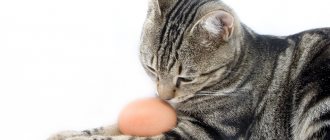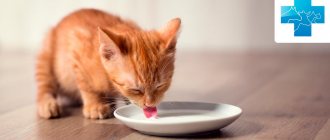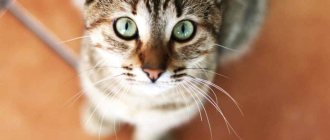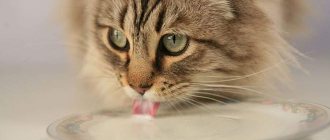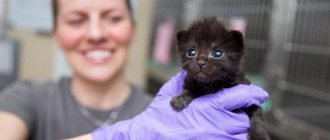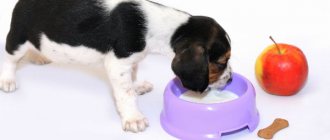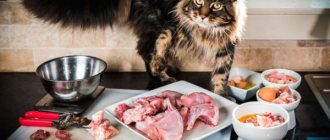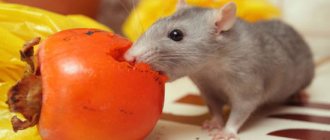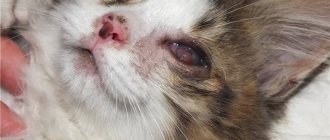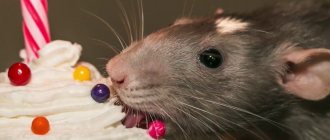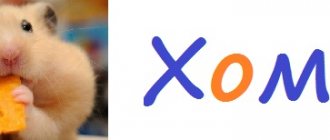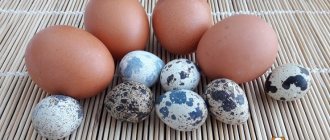Purebred kittens are very picky about their diet. This ordinary cat can be fed soup or bread, and it will be satisfied. In order to raise a Scottish cat that corresponds to the breed characteristics, you should take care of its nutrition from the moment of planned conception. It is very important that the cat from whom you plan to have offspring eats adequately before mating, during pregnancy and several months after the birth of the babies. The milk feeding period is important for the proper functioning of the gastrointestinal tract of babies. When trying to find out what to feed Scottish kittens, there are several important points to consider.
Can Scottish Folds be given milk?
The myth that fold-eared cats will develop funny curved ears from milk was invented by unscrupulous breeders. False information is shared for one's own benefit.
The fact is that purebred and expensive Scottish Folds have three folds on their ears, and as the kitten grows, they do not allow the ears to straighten. During breeding, for the sake of speedy profit and non-compliance with purebred mating, kittens appear with one fold, which smooths out with age and their ears stand up. Such babies should be sold much cheaper than their purebred brothers, which is why buyers listen to the fairy tale about milk and calcium, buying culls at an inappropriate price. The kitten will never refuse such a treat as milk, and when asked about erect ears, the seller will have a ready answer about non-compliance with the recommendations.
Advantages of ready-made feeds
Why are more and more owners of kittens switching to ready-made food? Perhaps the secret is that everyone wants to have a kitten, but there is simply no one to care for and feed it. Constantly being busy at work means that owners have no time to boil meat, fish, or grind food to remove bones.
Ready-made food has many advantages. Premium mixtures are designed for feeding cats, taking into account their age, body type, belonging to a specific breed, and are even available for neutered and lactating pets.
Popular foods that are suitable for Scottish babies:
- Wahre Liebe "Junge", produced in Germany. The food contains colostrum, so the product is well absorbed and can be used for feeding from the earliest months. In addition, the food contains chicken and turkey meat, as well as rice, egg and beet pieces. The manufacturer assures that the food can be used to prevent urolithiasis.
- Fans of the fish menu will appreciate Hill's Science Plan Kitten Tuna - dry food, made in the USA. It contains: floured tuna meat, chicken, animal fat, flaxseed, corn, beets, fish oil, Omega-3 and Omega-6 acids. Kittens really like the food. Long-term use helps strengthen the immune system.
- Canadian manufacturers offer high protein dry food 1st Choice Kitten. It contains, in addition to chicken and herring meat, rice, barley, oatmeal, egg powder, tomato and beets. The food is hypoallergenic, therefore suitable for pets suffering from food allergies.
- Another dry food from French manufacturers is Royal Canin British Shorthair Kitten, containing dried poultry meat, extract from cartilage and crustacean shells, fish oil, corn, and chopped beets. According to the annotation, the food is a preventative against joint pathologies.
- For lovers of wet food, the French offer Royal Canin Kitten Instinctive. In addition to meat and meat products, it contains cereals, yeast and milk.
- The manufacturer Purina Pro offers Plan Dental Plus food for small kittens. The unique composition allows you to maintain your pet’s oral cavity in excellent condition. The food prevents the formation of dental plaque.
- Hills high carbohydrate food is designed for active kittens. It contains calcium and magnesium, which the baby needs for full development. The food is not suitable for overweight kittens.
The calorie content and consumption rate must be indicated on food packages, so you must follow the manufacturer’s recommendations. The average norm for a Scottish kitten is 200 kcal.
Ready-made food is divided into the following types:
- dry;
- wet;
- semi-moist.
When choosing dry food, you need to remember about constant access to a drinking bowl, otherwise the cat will have problems with bowel movements.
Dry and wet formulations from the same manufacturer are allowed to be used for mixed feeding. At the same time, they are not combined into one feeding, but distributed alternately:
- one feeding – dry portion;
- second feeding - wet canned food.
Dry food must be stored properly. Before purchasing a package of food, you should pay attention to the following points:
- expiration date and storage conditions;
- manufacturer's brand and type of food (it is best to choose a premium and holistic line);
- the age of the pet indicated on the packaging and actual age;
- special additives. The food may contain increased amounts of certain microelements and vitamins. Feeds are not only balanced, but also medicinal. Not all kittens need special food, so you should pay close attention to the instructions on the food.
The benefits and harms of milk
Milk is a unique product created by nature. In addition to proteins and fats, it contains trace elements and minerals necessary for a growing body, calcium and potassium, phosphorus and magnesium, vitamins and lactose.
Lactose is milk sugar that is easily digestible and broken down by enzymes, but with age they disappear and the body stops absorbing milk.
In many individuals of the cat tribe, this restructuring occurs after the transition to solid food. With a lack of trace elements and calcium, curvature of the hind limbs, fragility of bones and claws may occur.
How to feed fold-eared kittens correctly
There is no need to deprive a lop-eared Scot of such a delicacy. Natural cow's milk is diluted with boiled water 1:2; in this form it will not cause any harm and will be easily digested by the kitten. Milk is given separately and not mixed with other natural foods.
Cottage cheese, kefir, fermented baked milk or any other fermented milk product, fish, egg yolk will sufficiently replenish the growing body with calcium and potassium without consequences.
A properly selected diet and calcium content in food is important for the growth and formation of the musculoskeletal system. Such a large breed as the Scottish Fold requires high-quality and nutritious nutrition.
Source
What to feed
Today, veterinarians claim that you can feed cats only with ready-made food or prepared food yourself , and this is not without reason, since by now a lot of experience has been accumulated in animal nutrition.
At the same time, it is impossible to mix homemade food with ready-made food, since this is fraught with various distortions, for example, if you feed a cat with dry food and at the same time feed it with meat, it will develop an excess of protein, which manifests itself in the form of eye boogers.
But these are still “flowers”, it is much worse when the animal does not have enough vitamins, or, on the contrary, there are too many of them - in this state the animal will suffer very much.
Can Scottish Fold cats have milk?
There is an opinion that Scottish Fold cats should not drink milk and generally consume a lot of foods rich in calcium, so that their ears do not stand up. Is it so? And if so, then why can’t lop ears have milk?
In fact, there is no evidence that calcium products affect the process of ear erection in Folds, despite the fact that some breeders often scare buyers with this. According to veterinarians, in this way unscrupulous “breeders” absolve themselves of responsibility for erect ears in the future: they say, they were fed incorrectly - so they straightened up. True, some illiterate veterinarians themselves believe in this myth.
As practice shows, folds' ears can stand up for other reasons. And this has absolutely nothing to do with whether a Scottish kitten can have milk. One of the reasons is genetic: if a kitten’s genes are not ideal, and its ancestors have erect ears, then with a high degree of probability his ears will stand up too. Only many dishonest breeders are silent about this.
In fact, calcium is vital for fold-eared cats, as well as for straight-eared ones, because it is a building material for bones. Therefore, even if there was a choice whether to give the cat foods rich in calcium so that he would be healthy, or not so that he would be beautiful but sick, a conscientious cat owner would still choose the first option.
However, milk is still undesirable for Scottish kittens from a certain age. True, not at all because their ears can stand up. The fact is that, starting from 3 months, almost all cats cannot fully process lactose. As a result, they, like people, develop intolerance. In this case, the cat may greedily pounce on a bowl of milk, but its behavior in this case does not mean anything. Yes, cats love milk, but, as a rule, it doesn’t make them feel good afterwards. Drinking milk results in indigestion, diarrhea and gas. Sometimes the signs of dyspepsia are not clearly expressed - and the owners do not understand that the cat is unwell. However, most cats can drink milk in quantities of no more than 40 grams per 1 kilogram of animal weight without consequences.
At the same time, it is beneficial for both kittens and adult cats to eat fermented milk products: they are also rich in calcium, and they also normalize the intestinal microflora. The main thing is that they are not too greasy. This is kefir, fermented baked milk, yogurt, sugar-free yogurt, but not sour cream. Fermented milk products are served in a separate bowl; they do not need to be mixed with anything.
If you still have a strong desire to feed an adult cat milk, then it is better to opt for special lactose-free milk for cats. And if the cat really likes fatty sour cream, then it can be given occasionally after eating low-fat food in a small amount.
As for newborn kittens, who for some reason do not have a mother or she is not able to feed them herself, they definitely need milk. But there are some nuances here, which are described in a separate article.
For reference: the remainder of cow's milk per 100 g of product
Source
Features of a natural diet
Not all natural products can be used for the daily menu of Scottish kittens. The main list of permitted products is as follows:
- Beef is used raw or boiled. If the owners chose the first option, it is recommended to pre-freeze the meat. Many worms die from subzero temperatures. Kittens can be given meat from the age of 3 months. The portion should be small: approximately 30 g per feeding.
- Chicken breast. It is best used boiled and crushed. The portion should also be small; you can feed it from 2 months.
- The liver causes diarrhea in small kittens, so it is included in the diet occasionally (no more than once a week) and in small portions of 10-15 g, always boiled.
- Fish should be present in the diet, but not as a daily three meals a day. Use low-fat fish (for example, hake, blue whiting, carp, perch). Before feeding, the fish is boiled, the bones are removed, and you can grind it in a meat grinder until it becomes minced meat. Excess fish in the diet creates problems with kidney function.
- Egg yolk is introduced into the diet occasionally (1-2 times a week).
- Milk often causes stomach upset in adult cats, so it is better to include fermented milk dishes in the diet - kefir, low-fat cottage cheese, sour cream, fermented baked milk. Usually cats love this treat. You can pour a little kefir into a saucer at night, even if the kitten gets hungry, this feeding will allow it to last until the morning.
- Milk porridges are used to feed small kittens (up to 6 months). It could be semolina porridge or oatmeal, chopped buckwheat. Older pets should eat a side dish with butter or vegetable oil, but without milk, to avoid indigestion.
- Cereals (rice, buckwheat, egg, semolina, oatmeal) can be used together with a meat or fish dish. Cats are still predators, so the proportions must be observed: meat or fish - 2/3, side dish - 1/3. The side dish is added to the portion several times a week.
- Vegetables and herbs should also be present on the four-legged pet’s menu. This could be special grass, carrots, cucumbers, cauliflower. Vegetables are boiled, pureed and added to minced meat. Some cats express a desire to eat fresh vegetables and fruits (for example, cucumbers, melons, pumpkin). There is no need to interfere; perhaps the kitten has a lack of some vitamins in the body.
Fermented milk products should be used separately from the main menu. There is no need to add kefir to porridge or meat. Cottage cheese can be mixed with sour cream and served as an afternoon snack; kefir or fermented baked milk can be left overnight.
Need for vitamins
The menu for Scottish kittens should additionally include vitamins A and D. Veterinary pharmacies purchase special multivitamins for Scottish kittens or regular fish oil. This will saturate your small pet’s body with the necessary vitamins and microelements.
Drinking regime
A bowl of water should be in the baby’s constant access. This way he gets used to drinking the amount of water necessary for normal functioning. Scottish kittens are so spoiled that they will have to change their water twice a day. Any speck becomes a nuisance, and the baby looks for another place to quench his thirst.
Many pets get used to drinking only from the tap. Therefore, it is advisable to install a filter on the water supply system in your house or apartment.
List of harmful foods
There are foods that can harm the health of Scottish kittens:
- Pork is the main source of helminthiasis, so it is better to avoid feeding pork. There are two more compelling arguments why pork is harmful to cats. This is very fatty meat. In addition, this is the source of Aujeszky's disease. Pigs are considered the hosts of the pseudorabies virus. The virus is not dangerous for people, so the meat of slaughtered animals is not examined for virus carriage. A cat can become infected with false rabies by eating pork. The virus is deadly for kittens. Animals older than 1 year can cope with the disease, but this is done with great difficulty and not without the help of veterinarians. Only individuals with strong immunity survive.
- It is not recommended to include fats in the diet of kittens.
- Smoked and salty foods are extremely dangerous for children.
- You should not pepper, salt, or add various seasonings and spices to cats’ dishes; this can spoil the cat’s sense of smell and cause irreparable harm to health.
- Sweets and starchy foods are harmful to a growing body. Buns, cakes, ice cream, sweet drinks, and candies can disrupt metabolic processes in the body and cause obesity. Cats do not taste sugar, so they are able to eat a huge amount of treats. A regular excess of sugar in the diet causes disruptions in the functioning of the pancreas, which provokes the development of diabetes. Diabetes causes vision problems. The disease is accompanied by a sharp deterioration of vision or blindness. Chocolate contains theobromine, an alkaloid that causes a rise in blood pressure, excitement and an elevated pulse. A piece of sweet treat can turn into such a nuisance for your baby as severe theobromine poisoning. In the future, such experiments with nutrition can lead to cardiovascular pathologies. Urolithiasis occurs not only when a pet is addicted to fish. Sweets also cause kidney overload, which leads to the development of kidney diseases. Pregnant cats eating sweet buns can give birth to kittens with deformities. A passion for sweets leads to intrauterine fetal death and stillbirth. Dishes with sugar are dangerous for the development of an allergic reaction in kittens.
- Chicken bones can cause gastrointestinal injuries. When chewed, tubular bones form sharp edges that can pierce the stomach and cause inflammation, perforation, and peritonitis.
Is it possible to give milk to a Scottish Fold kitten?
In movies they often show how a bowl of cold milk is poured in front of a cat and she drinks it with pleasure. However, in the real world, giving your cat milk can do more harm than good. Although it may seem natural for a cat to drink milk, this is not entirely true. The truth is that cow's milk has no nutritional value for cats, and in fact, it can cause digestive problems for many. The reason is that most cats develop lactose intolerance shortly after weaning from their mother. This means they cannot digest the sugars found in natural milk, leading to digestive problems such as diarrhea.
What to feed a Scottish kitten by month
Purebred kittens are very picky about their diet. This ordinary cat can be fed soup or bread, and it will be satisfied. In order to raise a Scottish cat that corresponds to the breed characteristics, you should take care of its nutrition from the moment of planned conception. It is very important that the cat from whom you plan to have offspring eats adequately before mating, during pregnancy and several months after the birth of the babies. The milk feeding period is important for the proper functioning of the gastrointestinal tract of babies. When trying to find out what to feed Scottish kittens, there are several important points to consider.
Types of food
There are several options for feeding cats:
- natural, when the pet is offered a choice of meat, fish, minced animals;
- feeding with industrial feeds. These can be dry treats or jelly-like canned foods;
- mixed option, but it is not recommended to literally mix dry food and natural products. For breakfast there can be canned food, and for dinner a full-fledged minced chicken cutlet.
Veterinarians do not recommend using a mixed version, citing the fact that in this case it is difficult to avoid an overdose of vitamin supplements. An imbalance of vitamins and minerals in the body causes disturbances in the functioning of the body. Also, with mixed feeding, animals often experience digestive disorders and constipation, which can lead to diseases of the gastrointestinal tract.
The choice of food depends on the owner’s employment, their financial capabilities, and the pet’s taste preferences. It should be remembered that the diet should be varied, but at the same time balanced. Obesity is dangerous to the health of any cat. Problems with excess weight arise if the owners do not control the calorie content of their dishes and indulge their constantly meowing pet.
It is best to feed animals according to a schedule and a pre-compiled menu. Neutered cats are usually found with the problem of excess body weight, so special attention is paid to their diet.
Many pet owners argue about the correct choice of food. Some insist on a natural diet, others say that industrial feed is much healthier and tastier. It is difficult to prove anyone is right in this situation. Feeding natural foods is problematic for many. This requires frequent trips to the market or store. Meat and fish must be fresh.
In addition, fresh meat and fish delicacies may contain worm larvae, which can lead to the development of helminthiasis. To avoid infection, you will need to boil or bake a dish for cats, because fried food is harmful not only to the human body, but also to the cat’s stomach.
Ready-made food does not take much time to feed. It is enough to pour a certain portion to clearly know that your pet will not go hungry until the evening.
Selecting the power type
Every owner is faced with the question of what to feed Scottish Fold cats. The advice from veterinarians is that first of all, the owner must evaluate his time and financial capabilities.
Feeding natural and prepared foods is equally good. And only you can decide what is best to feed your Scottish. It doesn’t matter if you have a straight-eared or a fold-eared cat, make your food choices responsibly and rely on your pet’s preferences.
Natural food
Natural food is not food from the table, but products that completely replace commercial food for Scottish Folds in terms of the amount of nutrients, vitamins and minerals.
Cooking takes a lot of time, but you can be sure of the quality of what the animals eat. For cats, the menu should include sea fish (occasionally), lean meat (beef, chicken, rabbit), fermented milk products, eggs, low-carbohydrate cereals, vegetables, herbs, and vegetable oil.
Ready-made feed
To choose food for Scottish cats, you need to carefully study the basic composition, information about the manufacturer, reviews, then you will decide what is best to feed.
Super premium or holistic food is suitable as a cat's lunch. This can be wet or dry food.
Ready-made food brands such as Royal Canin, Akana, Fest Choice, Hills contain good quality meat and a large amount of vitamins.
Mixed diet
If you have not yet decided what to feed your Scottish Fold, then perhaps a mixed type of feeding will suit you. The advantages of such a diet are variety, the disadvantages are that it is difficult to determine the daily requirement.
It is also worth considering that the Scots love to eat and are prone to overeating. In addition, one feeding should not contain a mixture of natural and ready-made food. This can provoke various diseases.
General feeding rules
Typically, kittens are purchased at the age of 3-4 months, when their body is able to do without mother’s milk and is partially accustomed to new “adult” food. To correctly create a menu and feed your baby, you need to take into account a number of factors:
- The baby's stomach is very small, and activity is increased, so feeding should be frequent and portions small. For example, at the age of 3 months, a kitten is fed 5-6 times a day, and an older 4-month-old baby needs to be fed 4 times a day;
- a pet that does not have enough food will develop poorly, lag behind its peers, and often get sick;
- overfeeding is also dangerous. Unspent calories will definitely lead to obesity and disease;
- new products are introduced gradually, starting with small portions. Feeding with different foods must be alternated, that is, meat for breakfast, fish for lunch, cottage cheese for dinner. This is how the stomach learns new tastes and gradually gets used to them;
- You can’t pour the entire daily portion into your baby’s plate. His stomach is not yet able to control itself, which is dangerous due to overeating;
- food should not be too hot or cold. The kitten may get burned or have a cold in its throat. It is advisable to slightly warm foods before feeding.
Choosing food for a Scottish kitten
Homemade products
With age, Scottish cats may develop obesity or urolithiasis and obesity if not properly cared for. Home feeding should be ideally balanced with natural products. The diet includes:
- Lean meat. Scottish kittens are fed it daily in the form of mince, which, after preparation, is stored in the freezer for at least 24 hours. Before giving the minced meat to the Scots, it is doused with boiling water.
- Fish. It is given to kittens in the form of fillets, boiled in salt water for 20 minutes, once a week. Among the permitted varieties are hake, sea bass, and carp.
- Porridge. They are boiled in water. Buckwheat, barley and wheat groats are used for preparation. It is recommended to include porridge in the diet 3-4 times a week and mix it with meat.
- Vegetables. Depending on their age, kittens are given cooked or raw food 3-4 times a week. Pumpkin, carrots, zucchini, beets, and broccoli are best suited.
- Fruits. Many kittens love pears, apples, bananas and grapes. You should not feed them to animals more than once a week.
- Milk and dairy products. Ryazhenka, kefir, cottage cheese and cream can be given up to the age of 1 year 1-2 times a week. Products should not have too high a fat content.
- Grass. Finely chopped stems are good to mix with porridges.
It is important to enrich natural food with vitamins. Their deficiency leads to loss of coat shine and shedding. Feeding with natural products can be done in two ways:
- Immediately put the daily amount of food into the cat's bowl - kittens regulate their own food intake.
- Use portion feeding method.
New natural products are included in the diet of animals consistently.
Industrial feed
You can choose ready-made food, either dry or wet. Canned food should not be included in the daily diet of Scottish Straight and Fold kittens. Their composition is not well balanced enough for this.
When feeding wet food, you need to make sure that there are no uneaten leftovers left in the bowl.
It is better to start giving dry food from three months. It is not recommended to feed animals with industrial food from different manufacturers.
High-quality dry food:
- has a well-balanced composition;
- provides prevention of tartar;
- can be stored for a long time at room temperature without losing its original properties.
Dry food is convenient for feeding animals when the owner is absent for a long time. Industrial feed can be used to treat and prevent various diseases. For example, Hill's Prescription food is used to feed kittens:
- Diet s/d – for kidney diseases.
- Diet j/d – for joint diseases.
- Diet z/d – for food allergies.
For skin diseases, it is better to use industrial food ROYAL CANIN Skin Young Male.
Mixed feeding
A diet that includes homemade food and industrial feed is called mixed feeding. It is ideal for the care and nutrition of adult Scottish straight and fold cats and cats and allows you to maximally balance the diet.
Remember that excessive caloric intake causes obesity in animals. According to the rules:
- You cannot feed natural and industrial food at the same time;
- Feeds of different origins need to be fortified.
When mixed feeding castrated and sterilized cats, fish and salt are excluded from the food.
Feeding frequency
The number of feedings depends on the age of the kitten. The approximate diet and number of feedings per day are presented in the table (on a mobile device you can scroll the table horizontally with your finger):
| Pet's age, months. | Number of feedings | Example of products and dishes used |
| 1 | 6-8 | Warm milk semolina porridge, baby formula, a small amount of boiled chicken yolk. |
| 2 | 5-6 | Low-fat cottage cheese, milk, semolina porridge, a small portion of boiled and chopped meat (10-15g). |
| 3 | 4-5 | Boiled minced meat, cottage cheese, kefir, chopped vegetables, baked or boiled fish, porridge. |
| 4-6 | 3-4 | Fermented milk products, meat, minced meat, cartilage, fish, fresh and boiled vegetables. |
| over 6 | 3-2 | All permitted products. |
Artificial feeding of a newborn kitten
Usually babies up to 1-3 months are fed by a mother cat. There are situations when the offspring is left without a mother, and a person takes on the role of nurse. This is a very important mission, which sometimes seems impossible. Nothing is impossible, the main thing is desire and skill. The best option is to ask your friends if they have a nursing cat. Usually the mother does not refuse to feed her foundlings.
If this option is not available, start feeding from a pipette. Before feeding, babies are weighed, this allows you to determine the required amount of food. A 100-gram baby will need 30 ml of formula or milk, which is how kittens are fed during the first week after birth.
Starting from the second week, the nutritional intake is increased. For every 100 g of baby's weight, at least 38 g of liquid food is needed. In the third week, at least 48 g is already required. Starting from the next month, the norm increases to 53 g.
During the first month, the baby should receive food multiple times (up to 10 times a day). For feeding, warm milk or cream is used, which is poured into the baby’s mouth using a pipette or syringe without a needle. This must be done carefully so that the kitten does not choke.
Cow's milk is slightly different in composition from cat's milk. For example, there is less water in cat milk (70%) than in cow milk (88%), and the fat content is higher - 11% and 3.25%, respectively. But the most important difference is the amount of lactose. There is almost 2 times more of it in cow milk (5.2%) than in cat milk (3%).
The pet store sells a special formula for newborn kittens, which is similar in composition to a cat's mother's milk and is more suitable for feeding babies than cow's milk.
Sample menu by age
Kittens grow, get stronger, and along with this their diet and feeding schedules change. To get out of the situation, it is important for the owner to know the approximate menu by age. For ready-made food, portion sizes and number of feedings are indicated on the packaging. With a natural diet it is more difficult.
Up to a month
From birth to one month, Scottish kittens feed on their mother's milk. If the babies are left without a mother, then the owner feeds them using industrial cat milk substitutes, baby formula, or self-prepared formula.
Important! If the kittens are left without maternal feeding, then it is better to find a nurse cat for them. If this is not possible, then you will have to make every effort to fatten with substitutes.
1 month
Upon reaching 1 month, Scottish Fold kittens begin to be introduced to the first complementary foods. Here you can go in two ways: start with raw scraped meat (chicken, beef) or low-fat fermented milk products (ryazhenka, cottage cheese, yogurt).
Feeding with mother's milk or substitute continues. The total amount of food per day is 110–130 grams, meals – 7–8, can be changed depending on the needs of small pets.
2 months
At 2 months, the transition period begins - the kittens are gradually weaned from their mother or the amount of substitute consumed is reduced. Solid foods become more varied. Grated vegetables and bran are added to meat and dairy products.
After two months, the amount of food per day reaches 170–190 grams, 6–7 meals.
3 months
Kittens begin to be distributed at 3 months of age. This is a difficult period for pets, so you should approach feeding responsibly. New foods are added to the diet.
The basis of nutrition is not scraped, but finely chopped meat. Fermented milk products, vegetables, and fruits are introduced more actively in small quantities. At 3 months old, Scots can be introduced to cereals.
Amount of food – 230–250 grams per day, meals – 4–5.
4–6 months
At the age of 4–6 months, fish is gradually introduced into the diet - no more than 2 times a week. The meat is given in larger pieces. Greens are added to vegetables and fruits, preferably special grass, which can be purchased at a pet store.
The daily food intake depends on the size of the kitten. If it is large, then they give 310–330 grams, with medium sizes – 280–300 grams.
The number of techniques is reduced to three.
From 6 months to 1 year
The period from 6 months to 1 year is considered the completion of the development of a kitten into an adult animal.
The diet is as varied as possible, all permitted products are added.
The number of doses is reduced to two, the daily rate is also reduced and amounts to 5% of the animal’s weight.
